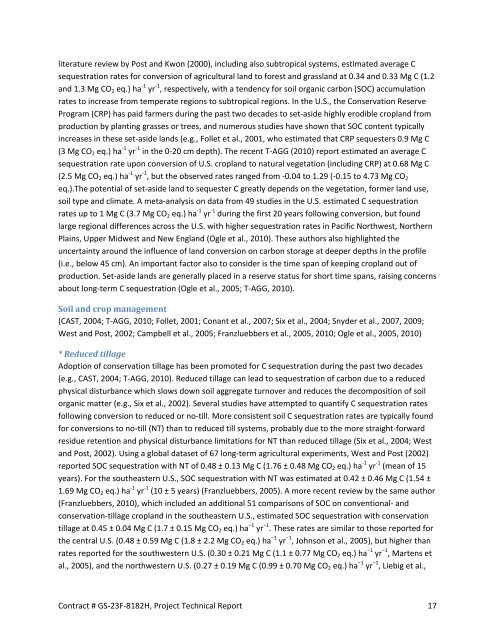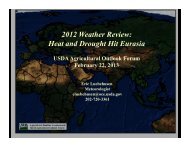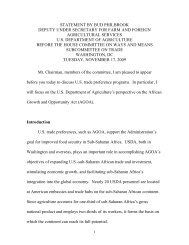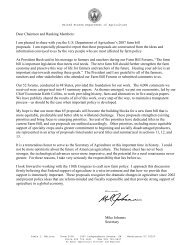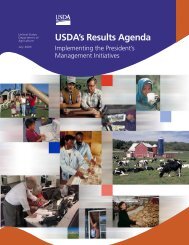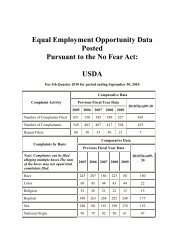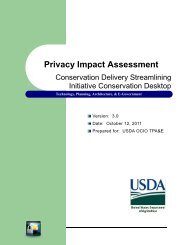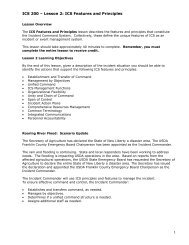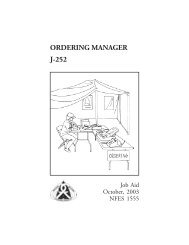Greenhouse Gas Emissions from U.S. Agriculture and Forestry: A ...
Greenhouse Gas Emissions from U.S. Agriculture and Forestry: A ...
Greenhouse Gas Emissions from U.S. Agriculture and Forestry: A ...
You also want an ePaper? Increase the reach of your titles
YUMPU automatically turns print PDFs into web optimized ePapers that Google loves.
literature review by Post <strong>and</strong> Kwon (2000), including also subtropical systems, estimated average C<br />
sequestration rates for conversion of agricultural l<strong>and</strong> to forest <strong>and</strong> grassl<strong>and</strong> at 0.34 <strong>and</strong> 0.33 Mg C (1.2<br />
<strong>and</strong> 1.3 Mg CO2 eq.) ha ‐1 yr ‐1 , respectively, with a tendency for soil organic carbon (SOC) accumulation<br />
rates to increase <strong>from</strong> temperate regions to subtropical regions. In the U.S., the Conservation Reserve<br />
Program (CRP) has paid farmers during the past two decades to set‐aside highly erodible cropl<strong>and</strong> <strong>from</strong><br />
production by planting grasses or trees, <strong>and</strong> numerous studies have shown that SOC content typically<br />
increases in these set‐aside l<strong>and</strong>s (e.g., Follet et al., 2001, who estimated that CRP sequesters 0.9 Mg C<br />
(3 Mg CO2 eq.) ha ‐1 yr ‐1 in the 0‐20 cm depth). The recent T‐AGG (2010) report estimated an average C<br />
sequestration rate upon conversion of U.S. cropl<strong>and</strong> to natural vegetation (including CRP) at 0.68 Mg C<br />
(2.5 Mg CO2 eq.) ha ‐1 yr ‐1 , but the observed rates ranged <strong>from</strong> ‐0.04 to 1.29 (‐0.15 to 4.73 Mg CO2<br />
eq.).The potential of set‐aside l<strong>and</strong> to sequester C greatly depends on the vegetation, former l<strong>and</strong> use,<br />
soil type <strong>and</strong> climate. A meta‐analysis on data <strong>from</strong> 49 studies in the U.S. estimated C sequestration<br />
rates up to 1 Mg C (3.7 Mg CO2 eq.) ha ‐1 yr ‐1 during the first 20 years following conversion, but found<br />
large regional differences across the U.S. with higher sequestration rates in Pacific Northwest, Northern<br />
Plains, Upper Midwest <strong>and</strong> New Engl<strong>and</strong> (Ogle et al., 2010). These authors also highlighted the<br />
uncertainty around the influence of l<strong>and</strong> conversion on carbon storage at deeper depths in the profile<br />
(i.e., below 45 cm). An important factor also to consider is the time span of keeping cropl<strong>and</strong> out of<br />
production. Set‐aside l<strong>and</strong>s are generally placed in a reserve status for short time spans, raising concerns<br />
about long‐term C sequestration (Ogle et al., 2005; T‐AGG, 2010).<br />
Soil <strong>and</strong> crop management<br />
(CAST, 2004; T‐AGG, 2010; Follet, 2001; Conant et al., 2007; Six et al., 2004; Snyder et al., 2007, 2009;<br />
West <strong>and</strong> Post, 2002; Campbell et al., 2005; Franzluebbers et al., 2005, 2010; Ogle et al., 2005, 2010)<br />
* Reduced tillage<br />
Adoption of conservation tillage has been promoted for C sequestration during the past two decades<br />
(e.g., CAST, 2004; T‐AGG, 2010). Reduced tillage can lead to sequestration of carbon due to a reduced<br />
physical disturbance which slows down soil aggregate turnover <strong>and</strong> reduces the decomposition of soil<br />
organic matter (e.g., Six et al., 2002). Several studies have attempted to quantify C sequestration rates<br />
following conversion to reduced or no‐till. More consistent soil C sequestration rates are typically found<br />
for conversions to no‐till (NT) than to reduced till systems, probably due to the more straight‐forward<br />
residue retention <strong>and</strong> physical disturbance limitations for NT than reduced tillage (Six et al., 2004; West<br />
<strong>and</strong> Post, 2002). Using a global dataset of 67 long‐term agricultural experiments, West <strong>and</strong> Post (2002)<br />
reported SOC sequestration with NT of 0.48 ± 0.13 Mg C (1.76 ± 0.48 Mg CO2 eq.) ha ‐1 yr ‐1 (mean of 15<br />
years). For the southeastern U.S., SOC sequestration with NT was estimated at 0.42 ± 0.46 Mg C (1.54 ±<br />
1.69 Mg CO2 eq.) ha ‐1 yr ‐1 (10 ± 5 years) (Franzluebbers, 2005). A more recent review by the same author<br />
(Franzluebbers, 2010), which included an additional 51 comparisons of SOC on conventional‐ <strong>and</strong><br />
conservation‐tillage cropl<strong>and</strong> in the southeastern U.S., estimated SOC sequestration with conservation<br />
tillage at 0.45 ± 0.04 Mg C (1.7 ± 0.15 Mg CO2 eq.) ha −1 yr −1 . These rates are similar to those reported for<br />
the central U.S. (0.48 ± 0.59 Mg C (1.8 ± 2.2 Mg CO2 eq.) ha −1 yr −1 , Johnson et al., 2005), but higher than<br />
rates reported for the southwestern U.S. (0.30 ± 0.21 Mg C (1.1 ± 0.77 Mg CO2 eq.) ha −1 yr −1 , Martens et<br />
al., 2005), <strong>and</strong> the northwestern U.S. (0.27 ± 0.19 Mg C (0.99 ± 0.70 Mg CO2 eq.) ha −1 yr −1 , Liebig et al.,<br />
Contract # GS‐23F‐8182H, Project Technical Report 17


